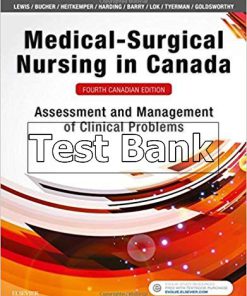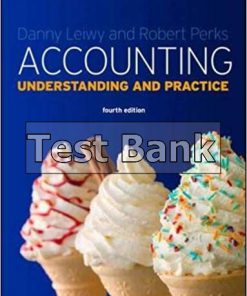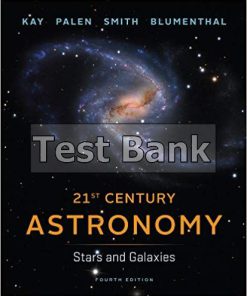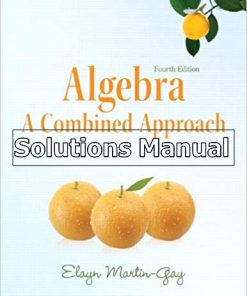Industrial Relations in Canada 4th Edition McQuarrie Solutions Manual
$26.50$50.00 (-47%)
Industrial Relations in Canada 4th Edition McQuarrie Solutions Manual.
You may also like
Industrial Relations in Canada 4th Edition McQuarrie Solutions Manual

Product details:
Author: Fiona McQuarrie
Fiona McQuarrie’s Industrial Relations in Canada received wide praise for helping students to understand the complex and sometimes controversial field of Industrial Relations, by using just the right blend of practice, process, and theory. The text engages business students with diverse backgrounds and teaches them how an understanding of this field will help them become better managers. The fourth edition retains this student friendly, easy-to-read approach, praised by both students and instructors across the country. The goal of the fourth edition was to enhance and refine this approach while updating the latest research findings and developments in the field.
Table contents:
- Chapter 1: An Introduction to Industrial Relations in Canada
- Introduction
- What Does the Term “Industrial Relations” Mean?
- Industrial Relations as an Academic Subject
- Why Study Industrial Relations?
- Industrial Relations Legislation in Canada
- The Question of Jurisdiction
- Labour Relations Laws
- Public Sector Labour Relations Legislation
- Occupation-Specific Labour Relations Legislation
- Employment Standards Legislation
- Human Rights Legislation
- The Charter of Rights and Freedoms
- The Unionized Workplace in Canada
- An Overview of the Book
- Summary
- Key Terms
- Discussion Questions
- Exercises
- References
- Chapter 2: Theories of Industrial Relations
- Introduction
- The Origin of Unions
- Theories of Union Origins
- The Webbs: The Effects of Industrialization
- Selig Perlman: Unions and the Class System
- John Commons: The Effects of the Market
- The Functions of Unions
- Robert Hoxie: Union Types
- E. Wight Bakke: Choosing to Join a Union
- John Dunlop: The Industrial Relations System
- The Future of Unions
- Karl Marx and Friedrich Engels: Unions and the Class Struggle
- Harry Braverman: The Effect of Deskilling
- Thomas Kochan, Robert McKersie, and Peter Cappelli: New Union and Employer Roles
- Richard Chaykowski and Anil Verma: The Distinctive Canadian Context
- Summary
- Key Terms
- Discussion Questions
- Exercises
- References
- Chapter 3: History of the Canadian Union Movement
- Introduction
- Canada as a Country: Distinct Characteristics
- Early Canadian Unionism: The 1800s
- The Industrial Age: The Early 1900s
- The First World War Era
- After the First World War
- The Second World War
- After the Second World War
- The 1950s and 1960s
- The 1970s and 1980s
- Into the 21st Century
- Summary
- Key Terms
- Discussion Questions
- Exercises
- References
- Chapter 4: The Structure of Canadian Unions
- Introduction
- The Local Union
- Structure of the Local Union
- Functions of the Local Union
- Regional, National, and International Unions
- Structure of Parent Unions
- Functions of Parent Unions
- Labour Councils
- Structure of Labour Councils
- Functions of Labour Councils
- Provincial Labour Federations
- Structure of Provincial Labour Federations
- Functions of Provincial Labour Federations
- National and Centralized Labour Federations
- National Labour Federations
- Canadian Labour Congress
- Centralized Labour Federations
- Quebec Federation of Labour
- Centrale des syndicats du Québec
- Confédération des syndicats nationaux
- International Labour Federations
- Summary
- Key Terms
- Discussion Questions
- Exercises
- References
- Chapter 5: The Organizing Campaign
- Introduction
- Factors Affecting Employee Support for a Union
- Personal Factors
- Workplace Factors
- Economic Factors
- Societal Factors
- Steps in the Organizing Campaign
- The Information Meeting
- The Organizing Committee
- Factors Affecting the Success of an Organizing Campaign
- The Application for Certification
- Sufficient Membership Support
- Appropriate Bargaining Unit
- Organizing in the Construction Industry & Organizing Through Voluntary Recognition
- The Construction Industry
- Voluntary Recognition
- Summary
- Key Terms
- Discussion Questions
- Cases
- References
- Chapter 6: Establishing Union Recognition
- Introduction
- Assessing the Certifi cation Application
- The Workplace Notice
- Determining Employee Support
- The Representation Vote
- The Hearing
- Special Circumstances during Certification
- Certification for a Previously Unionized Workplace
- Certification If the Parties Change
- Certification Applications during a Strike or Lockout
- Unfair Labour Practices
- Definition and Legislative Philosophy
- Legislation
- Dealing with an Unfair Labour Practice Complaint
- Remedies for Unfair Labour Practices
- Summary
- Key Terms
- Discussion Questions
- Cases
- References
- Chapter 7: Defining and Commencing Collective Bargaining
- Introduction
- The Effects of Certification
- The Framework for Collective Bargaining
- The Structure of Collective Bargaining
- The Participants in Collective Bargaining
- What Can the Parties Bargain For?
- Preparing to Commence Collective Bargaining
- Timelines for Collective Bargaining
- Setting Bargaining Priorities
- Preparing for the Start of Bargaining
- Bargaining in Good Faith
- Summary
- Key Terms
- Discussion Questions
- Cases
- References
- Chapter 8: The Collective Bargaining Process
- Introduction
- How Do Negotiations Work?
- Stages of Union-Management Negotiations
- Pre-negotiation Stage
- Establishing the Negotiating Range
- Narrowing the Bargaining Range
- The Crisis Stage
- Ratification
- Negotiation Stages and Negotiation Subprocesses
- The Subprocesses within Each Bargaining Stage
- The Role of Bargaining Power in Union-Management Negotiations
- Two Alternative Models of Union-Management Negotiations
- The “Cost of Disputes” Model
- The Mutual Gains Model of Bargaining
- Summary
- Key Terms
- Discussion Questions
- Cases
- Collective Bargaining Simulation Exercise
- Newtown School Dispute
- References
- Chapter 9: Strikes and Lockouts
- Introduction
- Defining Strikes and Lockouts
- Why Strikes or Lockouts Happen
- Motivations for Striking or Locking Out
- Bargaining Structure
- Individual Factors
- Economic Conditions
- Legislative Restrictions
- Bargaining Process Factors
- How Does a Strike or Lockout Begin?
- What Happens When a Strike or Lockout Takes Place
- Picketing
- Replacement Workers
- Ending a Strike or Lockout
- Putting Canada’s Strike Record in Context
- Summary
- Key Terms
- Discussion Questions
- Cases
- References
- Chapter 10: Third-Party Intervention during Negotiations
- Introduction
- Conciliation
- Mediation
- Other Forms of Mediation
- Interest Arbitration
- Total-Package Final Offer Selection
- Item-by-Item Final Offer Selection
- Mediation-Arbitration
- Using Conciliation, Mediation, or Arbitration
- Third-Party Intervention in Private Sector Bargaining Disputes
- Third-Party Intervention in Public Sector Bargaining Disputes
- Other Forms of Intervention in the Bargaining Process
- Final Offer Votes
- Industrial Inquiry Commission
- Disputes Inquiry Board
- Summary
- Key Terms
- Discussion Questions
- Case
- References
- Chapter 11: The Grievance Arbitration Process
- Introduction
- The Grievance in the Workplace
- Definition of a Grievance
- Types of Grievances
- Timeliness of a Grievance
- Steps in the Grievance Procedure
- Duty of Fair Representation
- The Grievance Arbitration Process
- Preparing for a Grievance Arbitration
- The Arbitration Hearing
- Order of Proceeding
- Creating the Arbitration Award
- Problems with the Traditional Grievance Arbitration Process
- Speed of the Process
- Formality and Legalism of the Process
- Cost-Effectiveness of the Process
- Alternatives to the Traditional Grievance Arbitration Process
- Expedited Arbitration
- Grievance Mediation
- Mediation-Arbitration
- Summary
- Key Terms
- Discussion Questions
- Cases
- Exercise
- References
- Chapter 12: Changes to the Union or the Employer
- Introduction
- Successorship
- Decertification
- Union Mergers
- Technological Change
- Workplace Restructuring
- Summary
- Key Terms
- Discussion Questions
- Cases
- References
- Chapter 13: Future Issues for Workers, Work Arrangements, Organizations, and the Industrial Relation
- Introduction
- Changes in Workforce Demographics
- Young Workers
- Female Workers
- Older Workers
- Ethnic and Racial Diversity in the Workforce
- Union Strategies for Dealing with the Changing Workforce
- Changing Work Arrangements and Practices
- Work Scheduling
- Telecommuting
- Different Employment Relationships
- New Human Resource Management Practices
- Union Responses to Changing Work Arrangements and Practices
- Changes in Organizational Structures
- Union Responses to Changing Organizational Structures
- Globalization
- Union Responses to Globalization
- What Happens Next? Factors Influencing the Future of Industrial Relations in Canada
- Legislation
- Political Influence
- Union Organizing
- Summary
- Key Terms
- Discussion Questions
- Case
- References
- Glossary
- Index
- End User License Agreement
People also search:
industrial relations in canada 4th edition pdf free download
industrial relations in canada 4th edition hebdon
industrial relations in canada 4th edition pdf download
industrial relations in canada 4th edition citation
industrial relations in canada 4th edition pdf free hebdon












